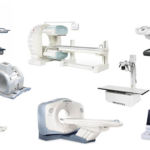Mechanical ventilation is a type of life support. It is a device that takes over the respiratory function when a human is incapable to breathe adequately. A ventilator, respirator, or breathing system is also termed a mechanical ventilator. There are many reasons that a patient would require a mechanical ventilator, but the most common reasons are inadequate levels of oxygen or severe shortness of breath from an illness. Ventilation is utilized to insert high oxygen levels into the lungs. It helps to get rid of carbon dioxide. It aids to reduce the amount of energy a patient needs to breathe so that their body can focus on fighting or healing from infection. It supports the breathing of a person who has severe nervous system impairment, such as spinal cord trauma, or flaccid muscles.
How does Mechanical Ventilator function?
A healthcare practitioner would pass an endotracheal tube into the nose or mouth of the patient and the windpipe (trachea) when a person needs to be on a ventilator. After that, this tube is connected to the ventilator. There are many tasks executed by the endotracheal tube and ventilator. To draw oxygen into the body, the ventilator forces a combination of air and oxygen into the lungs of the patient. To prevent the air sacs in the lung from collapsing, the ventilator needs to hold a steady volume of low pressure, called Positive End-Expiratory Pressure (PEEP). The endotracheal tube enables the suction of mucous from the windpipe to be removed by healthcare workers.
Most patients on a ventilator are monitored in an ICU. In this setting, everyone on a ventilator would be connected directly to a monitor that monitors heart rate, breathing rate, blood pressure, and saturation of oxygen. A ventilator can be lifesaving, but there are risks to its use. It does not resolve the issue that contributed in the first place to the person having the ventilator. It only stabilizes a person before more treatments become available or the individual gets healthier on their own.
Risk Associated
Patients on the ventilator are more likely to incur pneumonia, which may be a significant concern. Although until pneumonia is treated with antibiotics, the patient would need to stay on the ventilator for a long period. A part of the lung may often become unstable and create a void, making air escape causing lung failure. If the lung collapse is severe, it can lead to death. A tube needs to be inserted into the chest to extract the air that is leaked out to re-expand the lung. Then the tube would be withdrawn once the lung has recovered.
Ventilation Stockpile in COVID-19
The need for ventilation systems during COVID-19 quickly overrun many day-to-day operational capacities. According to the market database, the US healthcare sector stated that acute care hospitals operated nearly 62,000 full-featured mechanical ventilators before the pandemic began. Currently, market analysis tools indicate 28,883 of these ventilators (46.4%) are required to ventilate pediatric and neonatal patients. In the early months of the pandemic, one study indicated that intubation and intrusive ventilation were required in nearly 80,000 patients from Wuhan, China. The findings showed that ventilation was necessary in 3.2% of all COVID-19 reported cases, but some form of mechanical ventilation was needed in closer to 50% of cases admitted to intensive care.
According to the market database, the CDC Strategic National Stockpile (SNS) stocks and maintains mechanical ventilators that can be deployed across relevant networks on request to support the anticipated increase in demand. Three particular types of ventilators are stockpiled by the SNS: LP10 (Covidien), LTV1200 (CareFusion), and Uni-vent Eagle 754 (Impact Instrumentation). On March 13, 2020, Medicare and Medicaid Services confirmed that there were between 12,000 and 13,000 ventilators stored by the SNS. The regulation of this technology and its demand can be understood through the forecast data procured via Global Market Database.
Availability to other countries
According to the market database, significant challenges related to COVID-19 have been faced by low- and middle-income countries (LMICs), particularly countries to the south of the United States. For example, Mexico faced a shortage of adequate amounts of ventilators and has little access to the global business outlook to buy ventilators. Mexican entities came in late to place demands for the procurement of ventilators from various suppliers and were thus behind the list of wealthy countries that had earlier predicted their demands. Compared to those purchased by the United States, the ventilators available to Mexico are also quite distinct. Only small transport ventilators that have been adapted to be used as invasive ventilation were bought by Mexico or those initially intended to be non-invasive ventilators.
Innovative Measures
To satisfy increased demand, ventilator producers ramped up production, and corporations such as GM, Ford, Dyson, Rolls-Royce, and Tesla took initiatives to switch their manufacturing facilities to produce ventilators.
Throughout the pandemic, it has been found that some respiratory disease patients do not need intrusive mechanical ventilation. This has contributed to the use of many innovative types of non-invasive ventilation systems.
According to the market database, a helmet-shaped system has shown the potential to offer non-invasive bi-level ventilator treatment to patients that is better supported than the conventional type of face mask style BiPAP. During the COVID-19 studies in April/ May 2020, this helmet-style patient interface was studied in Italy. The study showed that 18.2% of patients who used these helmets needed intubation and mechanical ventilator, while 61.5% of face mask wearers needed intubation and ventilation.


